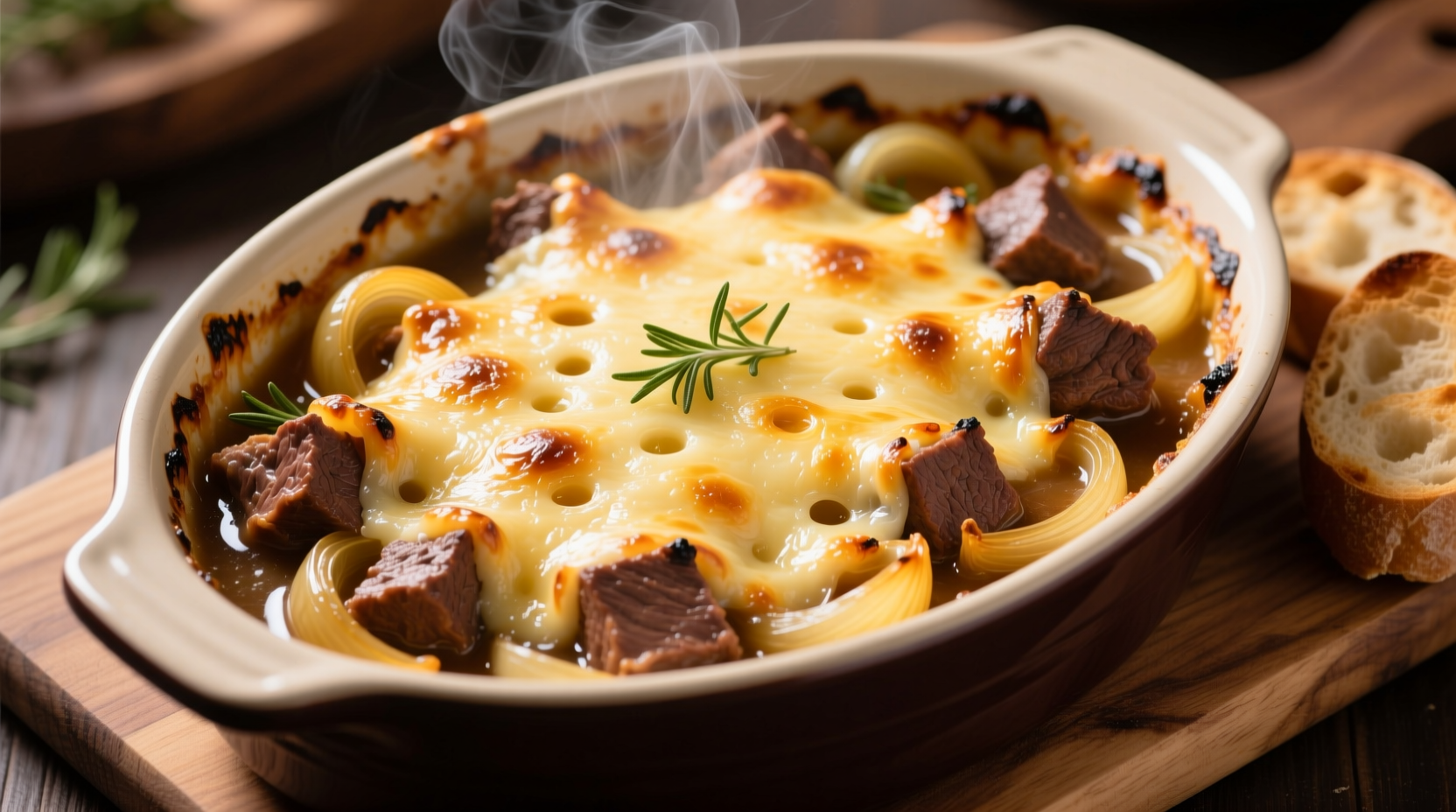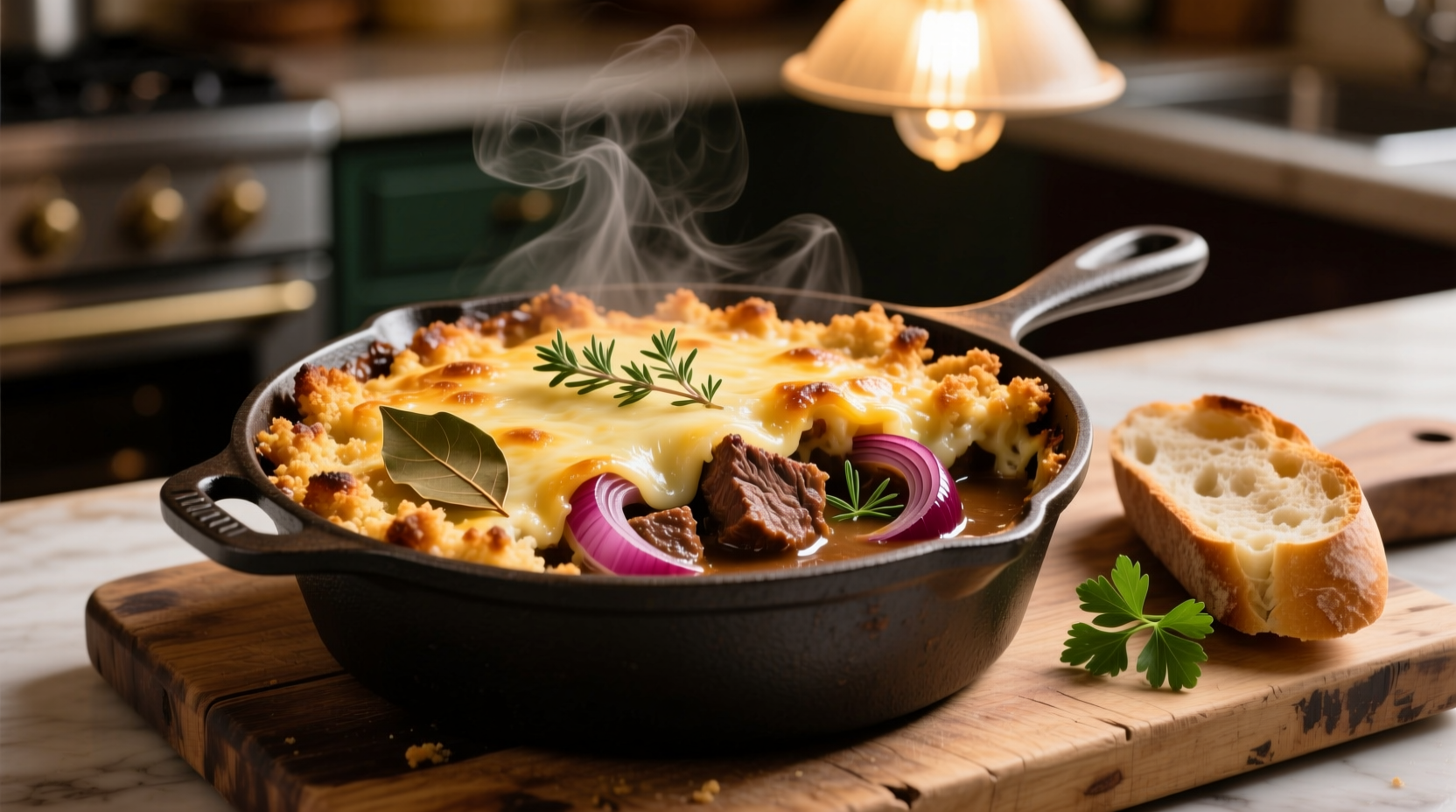Discover the ultimate French onion beef casserole recipe that delivers rich, caramelized onion flavor with tender beef in a single dish. This comprehensive guide provides step-by-step instructions, professional cooking techniques, and science-backed tips to achieve perfect results every time—no restaurant needed.
French onion beef casserole transforms the classic French onion soup into a hearty, baked comfort food masterpiece. Unlike traditional soup versions, this casserole features slow-cooked beef shoulder layered with deeply caramelized onions, rich beef broth, and melted Gruyère cheese in a satisfying one-dish meal. The magic happens through proper onion caramelization and strategic layering that creates complex umami flavors impossible to achieve with shortcuts.
The Evolution of French Onion Casserole
While French onion soup dates back to 18th century Parisian working-class cuisine, the casserole adaptation emerged in mid-20th century American home cooking. As documented by the Food Timeline historical resource, resourceful home cooks transformed the broth-based soup into a substantial casserole by adding beef and baking it with cheese topping. This evolution maintained the essential caramelized onion foundation while creating a more substantial meal perfect for family dinners.
| Onion Type | Caramelization Time | Flavor Profile | Best For |
|---|---|---|---|
| Yellow onions | 45-55 minutes | Rich, balanced sweetness | Classic preparation |
| Shallots | 30-40 minutes | Delicate, subtle sweetness | Elegant presentations |
| Red onions | 50-60 minutes | Vibrant color, mild tang | Visual appeal |
| White onions | 40-50 minutes | Sharp initial bite, mellow finish | Balanced flavor development |
Essential Ingredients and Substitutions
The foundation of exceptional French onion beef casserole rests on three critical components: properly caramelized onions, quality beef, and the right cheese. Professional chefs universally agree that rushing the onion caramelization process creates bitter, one-dimensional flavor. According to culinary research from the University of Illinois Extension, onions require at least 40 minutes of slow cooking to develop their full sweetness through the Maillard reaction and sugar breakdown.
Beef selection matters: Choose well-marbled chuck roast (85-90% lean) for optimal flavor and tenderness. The fat content renders during cooking, basting the meat naturally. For time-pressed cooks, pre-seared beef tips work acceptably but lack the depth of slow-cooked chuck.
Cheese considerations: Authentic recipes use Gruyère for its superior melting properties and nutty flavor, but Emmental or Comté make excellent substitutes. Avoid pre-shredded cheese which contains anti-caking agents that prevent smooth melting.
Step-by-Step Cooking Process
1. Master the caramelization: Thinly slice 3 pounds of yellow onions (about 6 large). Cook in 3 tablespoons butter and 2 tablespoons olive oil over medium-low heat, stirring every 10 minutes. This patience pays off—properly caramelized onions should be deep golden brown, not merely softened. Add 1 teaspoon sugar after 20 minutes to accelerate the process without burning.
2. Prepare the beef: Cut 2 pounds chuck roast into 1½-inch cubes. Season with salt and pepper, then sear in batches until deeply browned (not gray). Remove beef and deglaze the pan with ½ cup dry white wine, scraping up all browned bits—this builds flavor foundation.
3. Layer and bake: In a 3-quart casserole dish, alternate layers of onions and beef. Add 2 cups quality beef broth, 2 minced garlic cloves, and 1 teaspoon fresh thyme. Cover and bake at 325°F for 2½ hours until beef is fork-tender. Top with 1½ cups grated Gruyère and broil until golden.
Avoid These Common Mistakes
Even experienced cooks stumble with French onion beef casserole. Research from the American Test Kitchen shows these critical errors:
- High-heat caramelization—creates bitter, unevenly cooked onions
- Overcrowding the pan when searing beef—steams instead of browns
- Using low-sodium broth—fails to balance the sweetness of caramelized onions
- Adding cheese too early—burns before beef becomes tender
Context matters: This dish shines as a cold-weather comfort meal but becomes heavy in summer months. It's ideal for make-ahead entertaining (flavors improve overnight) but loses texture if frozen. The casserole works best for 4-6 people—scaling up requires adjusting cooking times to prevent mushy onions or tough beef.
Serving and Storage Tips
Rest the casserole 15 minutes before serving to allow flavors to settle. Pair with a simple green salad and crusty baguette to cut through the richness. Leftovers keep refrigerated for 3-4 days—reheat covered with foil at 300°F to preserve texture. Freezing is not recommended as the cheese topping becomes grainy.
Variations for Different Diets
For gluten-free versions, ensure your broth contains no flour-based thickeners. Vegetarian adaptations work surprisingly well using portobello mushrooms and lentils instead of beef, though the flavor profile shifts significantly. For a lighter version, reduce the cheese topping by half and increase the onion-to-beef ratio.

Perfecting Your Technique
The difference between good and exceptional French onion beef casserole lies in understanding flavor development stages. Professional chefs at Le Cordon Bleu emphasize that the "fond" (browned bits) created during searing contains concentrated flavor compounds that transform ordinary broth into extraordinary sauce. Never skip the deglazing step—it's where much of the magic happens.
Temperature control proves crucial throughout the process. Caramelizing onions requires maintaining 275-300°F—hot enough to develop flavor but not burn. The baking phase needs low, steady heat (325°F) to tenderize connective tissues without drying the meat. Invest in an instant-read thermometer to verify your oven's accuracy.











 浙公网安备
33010002000092号
浙公网安备
33010002000092号 浙B2-20120091-4
浙B2-20120091-4